The mourning dove, scientifically named the Zenaida macroura, is known by various names in the USA and UK.
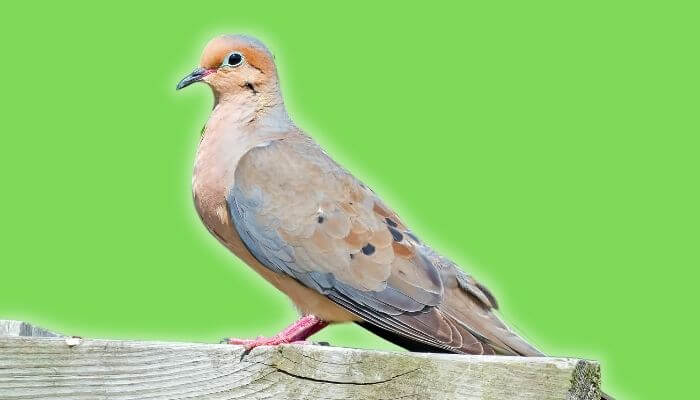
Formerly known as the Carolina Pigeon and Carolina Turtledove, today it is known as the Mourning dove (because of its distinctive call), American Mourning Dove, Turtle Dove and Rain Dove.
In the USA, Mourning Dove is most commonly used and in the UK, Turtle Dove.
The mourning dove is one of the most widespread and abundant birds in all of North America.
Mourning Dove Origins
As many of the different names for the bird suggest, it is accepted that the mourning dove originated in North America.
The interesting thing about this bird is that despite the huge number of them and the huge quantity of references and resources on Google, there seems to be no actual information about this bird’s origin.
It is widely accepted that it is a close relative of the now-extinct passenger pigeon.

One of the first known records is that of Mark Catesby who described the “Turtle of Carolina” in his 1731 work, Natural History of Carolina, Florida and the Bahama Islands, the first published account of the flora and fauna of North America.
After seeing a pair of the birds that had been shipped to the UK from the West Indies, George Edwards described them as “long-tailed doves” in his 1743 work, A Natural History of Uncommon Birds.
There was however some confusion.
In the Catesby work, the opposite page was given over to the Passenger Pigeon.
Initially, Carl Linneus – the Swedish founder of the modern taxonomic system – documented the Latin names and descriptions used by Catesby and Edwards in 1758, updating them further in 1766 in the 12th edition of Systema Naturae.
At this point there were three birds named and documented – the passenger pigeon (Columba migratoria), the mourning dove (Columba cariolensis) and Edward’s mourning dove (Columba marginata).
It wasn’t until 1955 that the International Commission on Zoological Nomenclature designated the two species and the two names of Columba migratorius for the passenger pigeon and Columba macroura for the mourning dove.
Distribution And Habitat Of The Mourning Dove
As we mentioned previously, the mourning dove is one of the most common and widespread birds across the entirety of North America.
They are prominent all year round across the vast majority of the United States, Southern Canada, Bermuda, Central Mexico, some of the Caribbean islands and even as far south as some of Central America.
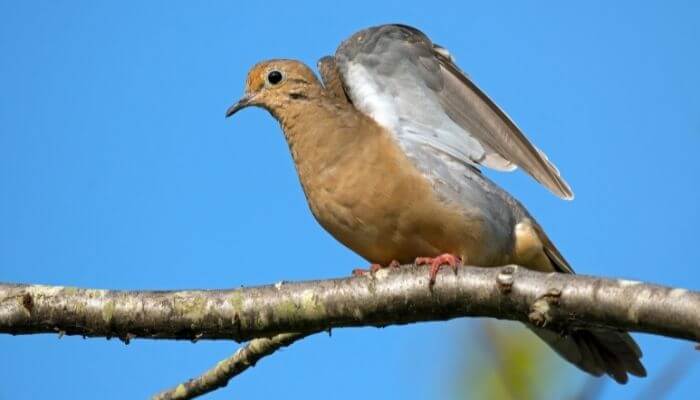
Though widely distributed, there are actually five subspecies of the mourning dove although their distribution does overlap and it is hard to distinguish between the various species:
- Marginella– west Canada and west USA to south-central Mexico
- Carolinensis – east Canada and east USA, Bermuda, The Bahamas
- Macroura – Greater Antilles (Cuba, Puerto Rico, Dominican Republic, Haiti, Jamaica and Cayman Islands)
- Clarionensis – Clarion Island (off west Mexico)
- Turturilla – Costa Rica, west Panama
Their range covers an incredible 4,200,000 square miles (11M km²).
Despite their short lifespan (averaging 1.5 years) Mourning Doves are so populous that up to 20 million birds can be shot for both sport and meat per year without making a dent in the average numbers and conservation status of the bird.
Estimates from the Cornell Lab of Ornithology suggest there is in excess of 350 million mourning doves in the United States alone.
According to the IUCN, the conservation status of the mourning dove Least Concern and the species shows no signs of depleting in the near to distant future despite its popularity as a gamebird.
The preferred habitat of the mourning dove is open country, with scattered trees and woodland edges to explore, hide, rest and sleep.
During the colder winter months, they tend to roost in woodlots, and they feed on the ground in areas like grasslands, roadsides, backyards and agricultural fields.
Some mourning doves are migratory.
They will migrate north in Spring (March to May) and south in Fall (September to November).
Migration happens in flocks at low altitudes during the day with immature birds going first, then adult females, then adult males.
They can fly at speeds up to 50 mph and in very straight lines.
Mourning Dove Appearance
The bird weighs around 4 oz to 6oz (125g to 170g) and grows to around 12 inches (30cms) in length.
The mourning dove has a plump body and a long tail, with short legs, a short bill and head that might look particularly small in comparison to its body.
Its long, pointed tail is something that is unique among the various species of North American doves.
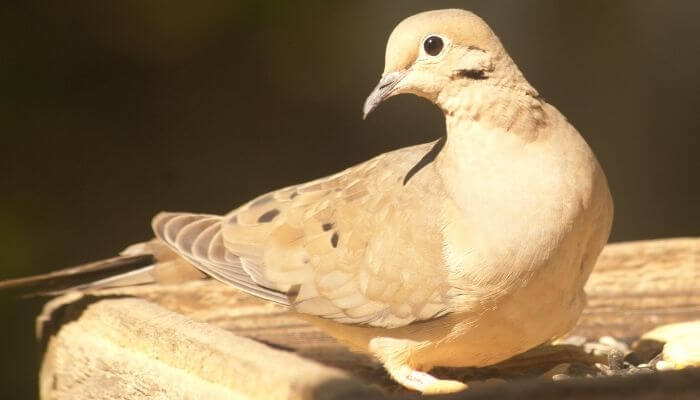
In terms of pattern and colouring, the development of a mourning dove has done it a lot of favours, with its colouring often matching the open country environment in which it prefers to dwell giving it great camouflage.
The colour scale runs from delicate brown to buffy tan, with signature black spots on the wings.
The black theme continues on the wings, as they will be black-bordered with white tips that go all the way down to the tail feathers.
The Mourning Dove is often confused with the Eurasian Collared Dove, yet they do have numerous striking differences.
It is legal to hunt Eurasian Collared Doves all year round as they are invasive species, this is not true of Mourning doves so if you plan to do any dove hunting make sure you know the difference!
Character and Behaviours
A wild mourning dove generally has a skittish and wary character.
This is hardly surprising given how widely they are hunted and the number of predators to contend with. It has even been said that the Mourning Dove is a game bird born to be eaten, so they are very cautious of any potential threats.
If approached, they will become startled and flee out of harm’s way.
One of their most characteristic behaviours is sunbathing and rain bathing.
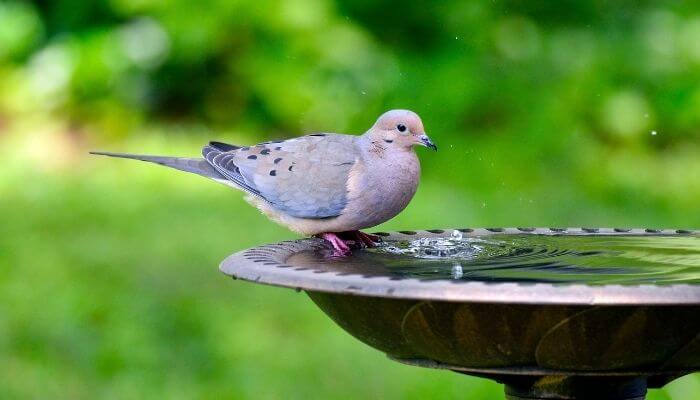
Many bird species do this but the mourning dove has a peculiar stance where they lie on a flattish surface, lean over and stretch out one wing.
They can hold this pose for up to twenty minutes.
They are also fond of a dust bath.
Another distinctive characteristic is their vocalisation.
Named for their mournful and haunting sound, it is a coo-oo-oo-woo-woo-wooo.
This is used by males to attract a mate.
They also have a soft cooOOoo as a nesting call and a soft “ork” as a greeting.
Their alarm call is a clipped roo-oo.
Male mourning doves tend to have favoured ‘cooing perches’ that they will claim as their own, defending them from other males.
Their Diet
Mourning doves are ground-feeding birds.
They will peck and push amongst litter if they find it but the overwhelming majority of the mourning dove diet is the various kinds of seeds it can find in their habitat.
Seeds make up 99% of a mourning dove’s diet, and this can include cultivated grains, wild grasses, herbs, weeds, sometimes even peanuts and occasionally berries.
The other 1% of the diet consists of snails, slugs and other invertebrates.
The bird can eat 12-20 per cent of its own weight every day – something around 70 calories.
Mating and Breeding Mourning Doves
Courtship begins with a noisy flight by a male followed by an elaborate and graceful circular slide with wings stretched wide and head down.
If the female likes what she sees, the pair will begin to bond and this will generally be demonstrated in the form of preening one another’s feathers.
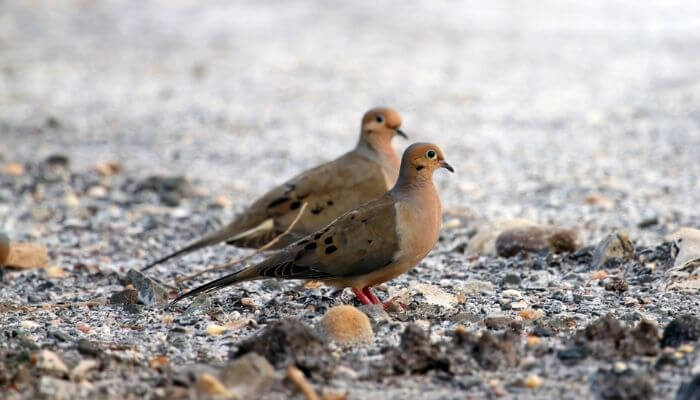
Both birds in a pair are active in organizing a nest site, with the male leading the female to a number of potential sites and the female ultimately choosing the one that she wants to use.
The female builds the nest, with the male flying around to gather the nesting materials for her.
Two eggs is almost always the usual number for a mourning dove pair, and in common with other Columbidae species, both the male and female take turns to incubate.
Their eggs will hatch within 14 days of mating.
Mourning doves are very devoted and serious parents, with an egg-filled nest hardly ever left unattended.
One of the reasons that mourning doves are able to sustain their huge population is the fact that a pair can produce up to six broods a year, with a pair often mating for life.
Other Interesting Facts
The mourning dove is the national bird of the US Virgin Islands.
The feathers of the bird are environmentally sensitive and will change color in response to changes of moisture in the air.
A lot of powerful spiritualism symbolism is attributed to the Mourning Dove.
This particular bird can mean a lot of different things to a lot of different cultures, but the most common interpretation is that the mourning dove is a symbol of peace, love and faith.
